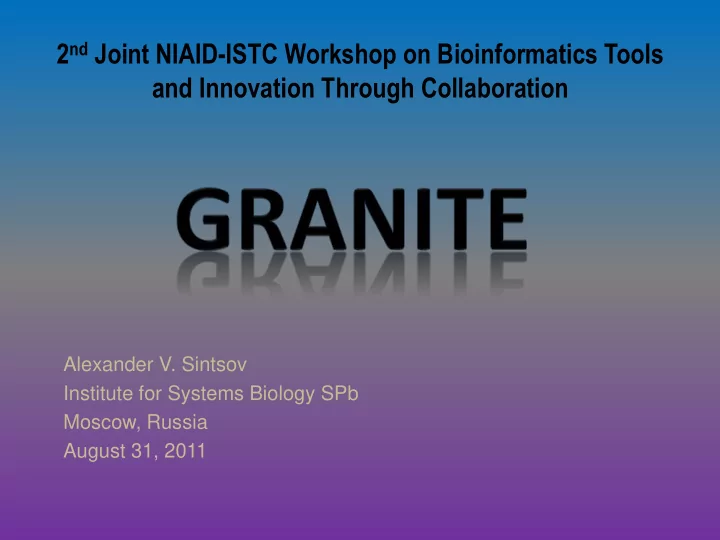

2 nd Joint NIAID-ISTC Workshop on Bioinformatics Tools and Innovation Through Collaboration Alexander V. Sintsov Institute for Systems Biology SPb Moscow, Russia August 31, 2011
National Institute of Allergy and Infectious Diseases (NIAID) Office of Cyber Infrastructure and Computational Biology (OCICB) Bioinformatics and Computational Biosciences Branch (BCBB) GRANITE is a new an agent-based genetic and metabolic regulatory pathways analysis tool designed to simulate, predict, and eventually discover genetic regulatory pathways and their associated emergent properties, with an emphasis on using this tool for model-based in silico drug discovery
GRANITE software consists of: a simulation environment where software agents can be organized into dynamic models (Scala) a domain specific language (DSL) that enables the system biologist to express agents and simulation context in a simple and concise form (Scala) a graphical user interface (GUI) for dynamic interaction with the simulation (Java) FEATURES • Agent-based modeling (ABM) and multi-agent simulation (MAS) • Stochastic scheduling tool • Conditional perturbation engine • Genetic algorithm • A change to an agent is immediately reflected in the simulation – no re-compilation or re-start is necessary • Furthermore, the state of the simulation can be check-pointed, or saved, such that if perturbations of the system destroy the integrity of the steady-state model, the simulation can be brought back to a stable state and new perturbations can be tested
GOALS OF ISB SPb To develop an algorithm allowing GRANITE: to take into account changes in environmental conditions like pH, and temperature to describe reactions with multiple substrates/products to take into account virtual drugs/compounds inhibiting one or several reactions to simulate the conversion of chemical stimuli into a desired cellular response for the purpose of simulating ultra-fast genome-wide signal transduction pathways and identifying the effects of drug screening and drug targeting mechanisms
DEFINITIONS Many enzymes catalyze reactions between two or more substrates. Using the nomenclature of W.W. Cleland [Biochim. Biophys. Acta, 67 (1963) 104-37] , the number of substrates participating in the forward and of products participating in the reverse reaction will be expressed by the terms: (1) uni (2) bi (3) ter (4) quad (...) and so on. E.g. , two substrates being condensed into one product is a bi uni mechanism. Two-substrate reactions can be classified as ping-pong or sequential. In ping-pong mechanisms , product is already released before all substrates are bound. In sequential mechanisms , all substrates must bind before product can be released. Furthermore, sequential mechanisms can be ordered or random. In ordered sequential mechanisms , substrates react with enzyme, and products are released, in a specific order. In random sequential mechanisms , on the other hand, the order of substrate combination and product release is not obligatory.
For this mechanism, there is no particular order in the sequential binding of substrates A or B to the enzyme to form the ternary complex E AB . Such a mechanism is typical particularly adenylate kinase.
CONCLUSIONS The Michaelis-Menten kinetics for monosubstrate reactions is based on • steady-state assumptions. Therefore, for multysubstrate reactions such assumptions might be used for the Michaelis-Menten kinetics-based models (as GRANITE). • The steady-state approach allows us to find the rate equation for any enzyme, but in some cases it can be extremely complex and practically useless. The steady-state approach works for two-substrate irreversible, and reversible • ordered and ping-pong reactions, but for two-substrate reversible random reactions it gives a very complex equation These equations explain the mechanisms, while the agent-based approach of • GRANITE attempts to model these mechanisms. The challenge is to translate these kinetic equations into an environment where the agents (the reactions) can learn the kinetic parameters. Our collaboration with NIAID and the OCICB involves developing a way to perform this translation.
Recommend
More recommend